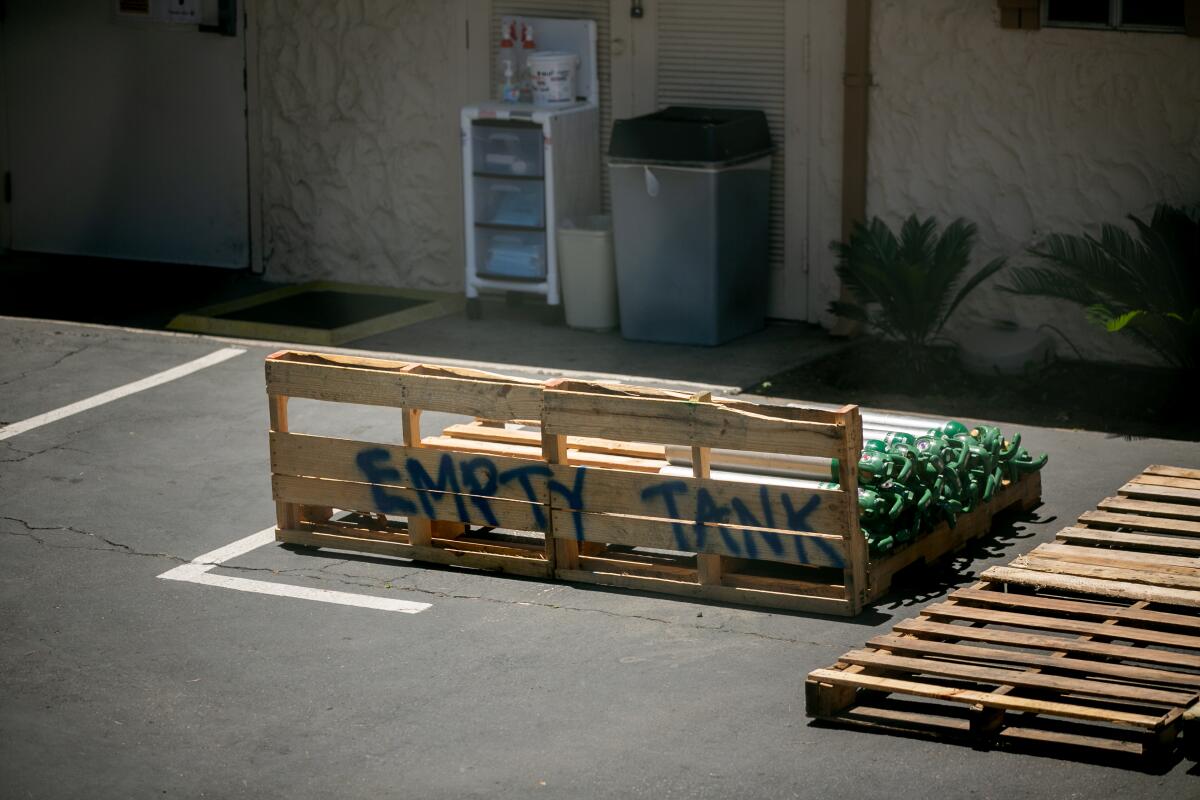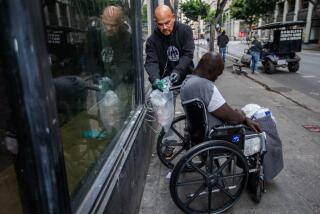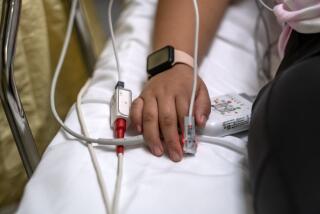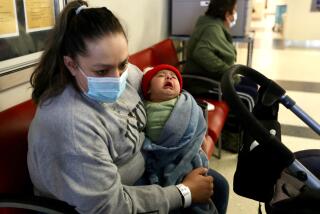Hospitals are still short of oxygen, critical for COVID-19 patients. Here’s why

- Share via
After almost two weeks in the hospital battling COVID-19, Gerardo Mercado was ready to go home. There was just one problem: He couldn’t get portable oxygen cylinders to aid his recovery there.
Southern California hospitals are struggling to get enough lifesaving oxygen to patients as they weather the COVID-19 surge, revealing infrastructure problems at old buildings and a supply-chain backlog with critical consequences.
“Our hospitals have never experienced this kind of strain on the oxygen supply chain,” said Adam Blackstone, vice president of external affairs and strategic communications with the Hospital Assn. of Southern California, which represents 180 hospitals.
COVID-19 hospitalization rates in L.A. County have come down from their alarming highs of two weeks ago, improving the oxygen pipeline to hospitals. But hospital administrators and medical suppliers say problems with refill and delivery of oxygen tanks are still hampering the medical response.
It’s partly a hospital infrastructure problem, as some aging and overworked pipes that funnel oxygen to patients have frosted, slowing down or even stopping oxygen transmission.
There are also not enough concentrators, which extract oxygen from the air, and tanks to meet demand at hospitals or for patients to take home when they’re discharged. On the distribution side, the number of trucks available to deliver oxygen has been stretched thin.
To deal with the surge in demand, some companies are bringing in medical oxygen from other states — sometimes as far as 1,000 miles away — or increasing production locally, said Rich Gottwald, president of the Compressed Gas Assn. trade group, which represents about 90% of the industrial and medical gas industry.
To help accommodate, California has temporarily loosened restrictions regulating the transport of oxygen, oxygen equipment and other COVID-19 supplies, including the limit on how many hours a truck driver can be on the road. State officials have also set up a task force to address the oxygen supply issue.
At least one part of the supply chain is intact: the oxygen molecules themselves. Industry experts say there’s no shortage of those. Factories that produce liquid oxygen for medical use simply pull in air from outside the building, carefully filter out any particles, and separate it into its components: nitrogen, oxygen and other gases.
The nitrogen can be sold to nearby heavy industrial plants, which use it to dry items or run meters, or it can be vented into the atmosphere.
The remaining liquid oxygen is loaded into freezer trucks that drive to hospitals and refill large tanks that supply oxygen to patients. The oxygen needs to stay chilled to remain in liquid form, which allows for more tons to be delivered than could be done with gas.
Transporting chilled liquid oxygen over long distances isn’t typically done because it’s expensive, but some companies are doing it amid surging demand. “They are going all out to bring product in,” Gottwald said.
Trucking in liquid oxygen from far-off places isn’t a sustainable option, in part because there aren’t nearly enough freezer trucks to do that, said Jonas Oxgaard, a senior U.S. chemicals analyst at Bernstein Research, an investment research firm.
“With a year’s head start,” it would “absolutely” be possible to build up large fleets of freezer trucks and train people to load and unload them, Oxgaard said. “But we didn’t because we didn’t see it coming.”
In addition to transportation issues, facilities and companies are struggling to get enough supplemental oxygen bottles and tanks, said Monica Vargas, spokeswoman for the California Governor’s Office of Emergency Services. That has led to a shortage of those cylinders and is “impacting gas companies’ abilities to fill replacement orders,” she said in an email.
Mercado, the hospitalized COVID-19 patient, said a case manager told him the hospital was having problems getting portable oxygen equipment for patients slated to go home.
The 62-year-old, a catheterization lab nurse who was hospitalized at his workplace, St. Francis Medical Center in Lynwood, knew how coughing spasms could leave him gasping for breath, and he wanted oxygen by his side.
His son scoured the internet for nearby medical supply stores. Many told him they were inundated with orders and wouldn’t take new customers, Mercado said. Eventually his son was able to rent an oxygen concentrator and oxygen cylinder.
He set them up in Mercado’s home and fired off a victorious text: “The eagle has landed.” Mercado is still recovering.
Medical oxygen vendors typically drop off oxygen cylinders to hospitals and other healthcare facilities, and pick up empty ones to refill and redistribute. With the recent COVID-19 surge overwhelming hospitals, empty cylinders aren’t being returned. Neither are some of the cylinders being used in patients’ homes, said Gottwald of the Compressed Gas Assn.
New cylinders can be made, but that takes time and money, he said. The trade group’s members are coordinating to bring more order to the process, ensuring that distributors drop off only as many cylinders as they receive and that hospitals return cylinders.
“In the hospitals’ defense, they’re just cycling through patients,” Gottwald said.
At Fountain Valley Regional Hospital, healthcare workers try to make sure that the storage racks of empty oxygen tanks are always full so the vendor can replenish them daily, said Christina Rodriguez, a respiratory care practitioner at the hospital.
“There are stragglers of tanks that might not get rotated through, but as long as we have a full rack of fulls, it’s the most important thing,” Rodriguez said. “We’re constantly trying to get those empty ones or the ones that are really low rotated back out.”
At Kaiser Permanente’s Los Angeles Medical Center in East Hollywood, staff added yet another task to their ever-growing list: teaching home-going COVID-19 patients how to use portable oxygen equipment.
Before COVID-19 hit, the oxygen supplies vendor would normally go to patients’ homes, deliver the equipment and teach them how to use it.
Now, delivery workers are inundated. Demand for oxygen supplies is so high that there aren’t enough drivers. And if patients don’t receive or learn how to use the equipment, they can’t be discharged from the hospital, where beds are sorely needed.
That left case managers such as Adriana Mendez lugging 40-pound concentrators and cylinders to patients’ rooms. “We just have to juggle, we have to prioritize,” said Mendez, a registered nurse in the Los Angeles Medical Center’s emergency department, where “if someone needs oxygen, that’s our priority.”
A state task force working to alleviate the supply and distribution problems is building oxygen depots in crucial areas, including one in Riverside County that opened last month. After the state initiated talks with the region, the depot got up and running within 72 hours, said Bruce Barton, the county’s director of emergency management.
Housed in a large county facility, the depot is staffed with state personnel from the Emergency Medical Services Authority and runs 24/7. It uses concentrators to fill large tanks with compressed oxygen for hospitals, which can use these portable tanks to help patients breathe as they’re being transported or treated in hospital areas such as conference rooms and gift shops that don’t usually house patients.
But these tanks don’t supply oxygen at a fast enough rate for critically ill patients, who typically rely on the high-flow oxygen that comes from the building’s pipes.
Meanwhile, there’s an additional way to help fix the oxygen shortage, Barton said: Communities at large can work to loosen the grip of the pandemic.
“It’s the hand-washing, the social distancing, the wearing of masks, getting the vaccination,” he said. “That’s really how we can drive down the demand side of this.”
More to Read
Inside the business of entertainment
The Wide Shot brings you news, analysis and insights on everything from streaming wars to production — and what it all means for the future.
You may occasionally receive promotional content from the Los Angeles Times.











